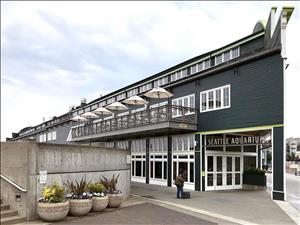The present site of the Seattle Aquarium was once a giant coal pier and the city's first commercial swimming beach (brrrr!). Both had disappeared by the late 1870s. A furniture mill and a succession of fish processors followed.
Seattle Fish Company
In 1893, fish merchants Ainsworth and Dunn’s Seattle Fish Company was located at the foot of Seneca Street, where the partners also handled hay grain and feed. Ainsworth & Dunn built today's Pier 59, originally called the Pike Street Wharf, before relocating to Pier 70 in 1901.
The first primary tenant for the new Pike Street Wharf was the hay and grain dealer Willis Wilbur Robinson. Robinson was born in Kansas in 1871 and came to Mount Vernon in 1890, where he had success as a farmer and learned the wholesale trade in hay and feed. He is first listed as operating at the Pike Street Wharf in the 1905 city directory. His stay at the foot of Pike Street lasted until about 1909, when he moved his operations to the newly reclaimed industrial area south of Pioneer Square.
The Market and the Hillclimb
Development of the upland Pike Street Public Market began in 1907, and it was linked to the waterfront by a variety of bridges and stairways, including today's Pike Street Hillclimb.
The hillclimb has a history all its own. At least five different trestles or stairways have been constructed to the waterfront from the site of the Pike Place Public Market. The first, in the 1870s, was the trestle leading to the Pike Street Coal Wharf. Next, in the 1890s a precipitous stairway was built to Western Avenue, beyond which a path continued to the shore. Between about 1911 and 1935 a narrow pedestrian trestle led from the Pike Market directly to the waterfront crossing Railroad Avenue (Alaskan Way) just north of the Pike Street Wharf. This trestle was cut off a short ways west of Western Avenue in 1935 for the construction of a seawall. Sometime later, the shortened trestle was replaced with the irregular system of steps.
Ground was broken for the Pike Place Market Hillclimb on January 17, 1977. Mayor Wes Uhlman, City Engineer Paul Wiatrak, and Paul Schell, then Director of the Department of Community Development, officiated. The $745,000 project linked the public market with the waterfront. Eberharter and Gaunt was the contractor chosen for an improvement that included stairways, terraces, landscaping, and a covered steel bridge over Western Avenue. At the time of dedication the city was still seeking an additional $350,000 to build an inclined elevator beside the stairs for handicapped persons and pedestrians who preferred to ride.
The elevator was finally constructed in the 1980s, and its operation turned over to the owners of the adjacent Fix Madore Building. It fell into disrepair in 1998 and sat unused for several years (the building owners declined to repair it and the city didn’t have the funds). It was reopened in the summer of 2004.
Seattle Aquarium
The Seattle Aquarium opened in 1977 after a long and bitter debate over where to put it. On April 1, 1977, before the opening, the American Consulting Engineers Council awarded the aquarium the Grand Conceptor Award for the highest achievement in engineering excellence.
On May 20, 1977, the aquarium held its grand opening for excited crowds. A total of 1,524 visitors toured the facility on opening day, and the Seattle Post-Intelligencer proclaimed "the Age of Aquarium."
Plans are now (2004) being developed for its expansion, possibly including Piers 62/63 to the north. The piers' Gaffney and Virginia Street pier sheds were razed in 1989. The surviving platform currently hosts summer concerts "On the Pier."
To go to Part 9, click "Next Feature"

